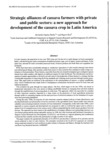Strategic alliances of cassava farmers with private and public sectors: a new approach for development of the cassava crop in Latin America
JIRCAS international symposium series
| ISSN | 13406108 |
|---|---|
| NII recode ID (NCID) | AA1100908X |

Full text
intlsymp-11_62-68.pdf858.71 KB
In Latin America, the population is now over 70% urban and this has led to rapid changes in food consumption habits, with declining per capita consumption of traditional staple crops, such as maize, cassava and beans. At the same time, demand for more convenient processed foods, livestock products and fresh fruits and vegetables has increased.
While there have been considerable attempts to 'modernize' agriculture in Latin America through land reform and technological change, there persists a small-farm sector in most countries that continues to make a large contribution to food production. These farmers, especially those that are situated in marginal agro-ecological regions distant from urban markets, still depend on traditional staples for their livelihood. The identification and development of market opportunities to diversify and add value to the production of these farmers is a strategy that has considerable importance in improving the living standards and vitalizing rural economies through income generation. This paper looks at evolution in the approaches to the transformation of cassava-a typical smallholder crop-from a traditional rural staple food to a multipurpose carbohydrate and protein source for food, feed and industrial purposes.
This evolution has gone through two major phases. The first, which began in the late 1970s, was based on institutional interventions that were aimed at linking smallholder farmers to emerging feed and food markets through the establishment of processing plants in rural areas. This approach, which was successful in a number of Latin American countries, depended to a large extent on the protection of local agricultural production through tariffs on competing imports and the state provision of technical assistance for the formation of cooperatives and processing enterprises.
During the early 1990s, the majority of Latin American countries adopted policies of trade liberalization and the decentralization and privatization of service provision to the agricultural sector. Import tariffs were reduced, subsidies removed and government extension services dismantled. Consequently, in the mid to late 1990s, a new approach to cassava research and development was proposed in order to confront the urgent need to achieve a greater level of competitiveness in the cassava sector, without marginalizing the small cassava producer from the process. The approach has been based on the establishment of strategic alliances and partnerships between cassava farmer groups and the private and public sectors. In 1998, the Latin American and Caribbean Consortium to Support Cassava Research and Development, CLAYUCA, was formed as a regional planning and coordination mechanism that currently involves the participation of eight countries in the region.
The paper explains the operational principles of CLAYUCA and describes a selection of its activities and the results achieved to date in Latin America. The principles involved in the CLAYUCA approach are currently being tested and adapted to local conditions in pilot scheme in Tanzania and Malawi, through the Southern African Root Crop Research Network, SARRNET.
While there have been considerable attempts to 'modernize' agriculture in Latin America through land reform and technological change, there persists a small-farm sector in most countries that continues to make a large contribution to food production. These farmers, especially those that are situated in marginal agro-ecological regions distant from urban markets, still depend on traditional staples for their livelihood. The identification and development of market opportunities to diversify and add value to the production of these farmers is a strategy that has considerable importance in improving the living standards and vitalizing rural economies through income generation. This paper looks at evolution in the approaches to the transformation of cassava-a typical smallholder crop-from a traditional rural staple food to a multipurpose carbohydrate and protein source for food, feed and industrial purposes.
This evolution has gone through two major phases. The first, which began in the late 1970s, was based on institutional interventions that were aimed at linking smallholder farmers to emerging feed and food markets through the establishment of processing plants in rural areas. This approach, which was successful in a number of Latin American countries, depended to a large extent on the protection of local agricultural production through tariffs on competing imports and the state provision of technical assistance for the formation of cooperatives and processing enterprises.
During the early 1990s, the majority of Latin American countries adopted policies of trade liberalization and the decentralization and privatization of service provision to the agricultural sector. Import tariffs were reduced, subsidies removed and government extension services dismantled. Consequently, in the mid to late 1990s, a new approach to cassava research and development was proposed in order to confront the urgent need to achieve a greater level of competitiveness in the cassava sector, without marginalizing the small cassava producer from the process. The approach has been based on the establishment of strategic alliances and partnerships between cassava farmer groups and the private and public sectors. In 1998, the Latin American and Caribbean Consortium to Support Cassava Research and Development, CLAYUCA, was formed as a regional planning and coordination mechanism that currently involves the participation of eight countries in the region.
The paper explains the operational principles of CLAYUCA and describes a selection of its activities and the results achieved to date in Latin America. The principles involved in the CLAYUCA approach are currently being tested and adapted to local conditions in pilot scheme in Tanzania and Malawi, through the Southern African Root Crop Research Network, SARRNET.
| Creator | Bernardo Ospina Patiño Rupert Best |
|---|---|
| Publisher | Japan International Research Center for Agricultural Sciences |
| Available Online | |
| Issue | 11 |
| spage | 62 |
| epage | 68 |
| Language | eng |
